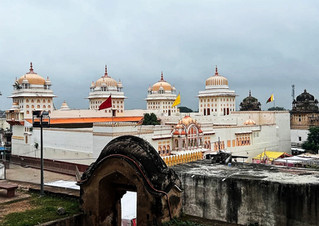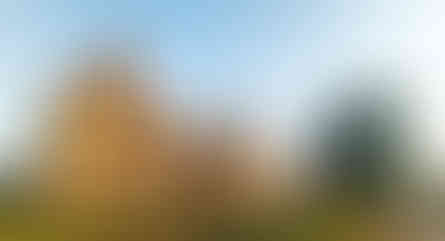Orchha: The hidden Gem of Bundelkhand - A Timeless Tapestry of History and Beauty : PART- I
- ashokkdas1958
- Jan 5
- 7 min read
Orchha : The Hidden Gem of Bundelkhand : PART- I : The Temples and Royal Chhatris outside the Walled Fort Complex
Orchha ! Meaning of the word ‘Orchha’ in local language is ‘hidden’. A quaint town nestled in the Bundelkhand region of Madhya Pradesh is Orchha, which average tourists tend to overlook. Founded by the side of scenic Betwa River in early 16th century by Bundela King Rudra Pratap Singh, Orchha had the distinction of being the capital of one of the largest and most powerful kingdom of Central India. Despite of that and true to the meaning of its name and thankfully included in the list of UNESCO heritage sites in 2020, Orchha is frequently eclipsed by its famous neighbours, Jhansi associated with its gallant Queen Rani Laxmi Bai and the famous UNESCO heritage the Khajuraho Temples. This is perhaps due to a combination of factors like:
· Jhansi's Historical Significance: Being associated with Rani Lakshmi Bai, a legendary figure in India's struggle for independence, Jhansi has a strong historical draw for many visitors.
· Khajuraho’s architectural Grandeur: Khajuraho being a UNESCO Heritage site for its much famous and publicized Temple complexs attracts much more tourists.
· It’s location: Being located between Jhansi and Khajuraho, Orchha sometimes gets caught in the crossfire of tourist itineraries.
· Lack of Major Tourist Infrastructure: While Orchha has been steadily developing its tourism infrastructure, it still lags behind Jhansi and other popular destinations.
A Glimpse into the glorious history of Bundela Dynasty
Orchha's rich history dates back to the 1501 AD when it was founded by the Bundela Rajput King Rudra Pratap Singh. The town flourished under the Bundela Kings, who built several magnificent temples and palaces. The town's strategic location along the banks of the Betwa River made it a significant trading post and a center of cultural activity. Orchha's architectural heritage reflects its glorious past, with numerous temples, palaces, and forts showcasing the exquisite craftsmanship and artistic traditions of the Bundela dynasty. The architectural heritage of Orchha is a testament to the grandeur and opulence of the Bundela dynasty.
The vast landscape of Orchha is dotted with majestic fort with imposing gateways, impressive palaces with its intricate frescoes and ornate decorations, magnificent temples each with its own distinct character, elegant chhatris (cenotaphs) and other monuments. A visit to Orchha without exploring these architectural marvels would be akin to visiting a museum without seeing the main exhibits. Similarly, any effort to describe Orchha, the Hidden Gem of Bundelkhand, without covering all these monuments will not do justice with the exquisite craftsmanship and artistic traditions of the Bundela dynasty.
Therefore, I will take you through the heritage tour of Orchha in two parts, first part covering the famous Temples located outside the walled Fort Complex and the picturesque Royal Chhatris on the Bank of Betwa River. In the next part I will be covering the grand monuments in the Walled Fort Complex.
A. The Kingdom of Raja Ram and Magnificent Temples
Orchha : Raja Ram’s Kingdom & Ram Raja Temple
One notable fact about Orchha is this small town is popularly known as Raja Ram’s Kingdom as this is the only place in country where Lord Ram is revered as a beloved king and not just a God. A guard of Honour held every day, police personnel designated as royal guards at the temple, befitting to the royal status of a king. The intricate carvings and vibrant colors of the temple make it a must-visit. The temple has a fascinating legend associated with it, which states that Lord Rama chose to reside here as a king.
The Legend behind Ram Raja Temple
According to local legends, the Ram Raja Temple in Orchha was once the palace of Queen Ganesh Kunwari, wife of King Madhukar Shah. A devout follower of Lord Krishna, the king wanted the queen to accompany him to Braj-Mathura, but she preferred to visit Ayodhya, the birthplace of Lord Rama. The queen's refusal to worship her husband's "Aradhya" angered the king, who ordered her to go to Ayodhya and return only with Lord Rama.
Upon reaching Ayodhya, the queen, a fervent devotee of Lord Rama, began praying near the Sarayu River. After a month of fervent prayers, Lord Rama appeared in the form of a child, known as "Ram Lalla." Pleased with her devotion, Lord Rama agreed to accompany her to Orchha on three conditions: he would travel only during the Pushya Nakshatra, upon reaching Orchha he would become the king, and the first place she seated him would be his final resting place.
King Madhukar began building a temple to welcome his wife and Lord Rama but by the time Queen reached back, the temple was still unfinished. The queen, exhausted from the long journey, took Ram Lalla to her palace and placed there. As per the conditions, Lord Rama claimed the palace, which became the renowned Ram Raja Temple. In this temple, Lord Rama is worshipped as "Raja Ram," a king, rather than a deity.
The unique palace-like architecture of the Ram Raja Temple sets it apart from other Hindu temples. Thousands of devotees visit the temple annually to seek Lord Rama's blessings. It is believed that Lord Rama resides in Ayodhya during the day and sleeps in Orchha at night. If you're planning a visit, be sure to include this magnificent temple on your itinerary to experience the divine presence of "Raja Ram."
Chaturbhuj Temple : A Celestial Abode of Lord Vishnu
The grand temple originally built for Lord Ram became most revered and magnificent Hindu temple dedicated to Lord Vishnu, the Chaturbhuja Temple. Construction of this temple was begun by King Madhukar Saha and was completed by his son King Vir Singh Deo in 16th century. The name "Chaturbhuj" means "four-armed," referring to the deity's iconic form. The temple's architecture is a blend of temple, fort, and palatial features, with a towering shikharas standing at 344 feet, one of the tallest among Hindu temples. The layout resembles a basilica and is said to represent the four outstretched arms of Lord Vishnu. The temple's exterior is adorned with intricate carvings and religious symbols, while the interior is relatively simple. A visit to Chaturbhuj Temple is a must for anyone interested in Hindu architecture and history.
Laxmi Temple: A Glimpse of Divine Beauty
A little away from the walled Fort and Chaturvuja Temple area stands the Laxmi Temple on a small hillock in a serene atmosphere with beautiful surroundings. This is a magnificent Hindu temple dedicated to Goddess Lakshmi, the goddess of wealth and prosperity. It stands as a testament to the rich cultural heritage and architectural splendor of the Bundela dynasty. The temple was built in the 16th century by King Vir Singh Deo, during the golden age of the Bundela dynasty. It showcases unique Bundela architectural styles, with intricate carvings, ornate pillars, and a towering gopuram. The temple's main attraction is the central sanctum, where the idol of Goddess Lakshmi is enshrined. The idol is believed to be miraculous and attracts devotees from far and wide. The ceilings and walls of the temple are adorned with intricate carvings and colorful murals and frescoes depicting mythological and religious themes, reflecting the artistic sensibilities of the era.
B. The Serene Beauty of the Royal Chhatris
The Chhatris of Orchha, Madhya Pradesh, India, are a stunning architectural ensemble that showcases the rich history and artistic heritage of the Bundela dynasty. These elaborate cenotaphs, built to commemorate the rulers of Orchha, are a testament to the grandeur and opulence of the kingdom. The Chhatris were constructed over several centuries, starting in the 16th century. Each chhatri is dedicated to a specific ruler, and their architectural styles reflect the changing tastes and influences of different periods. The most famous chhatris include those of Maharaja Sujan Singh, Maharaja Indramani, Maharaja Jaswant Singh, Maharaja Bhagwant Singh, Maharaja Sawant Singh and Maharaja Veer Singh Deo, Interestingly, the architectural style of Chhatri of Maharaja Veer Singh Deo is different from other Chhatris.
The Chhatris are typically made of sandstone and are characterized by their tall, pyramidal roofs, known as "chhatris." The roofs are supported by pillars and arches, creating a sense of grandeur and elegance. The exterior walls are often decorated with intricate carvings and sculptures, depicting various motifs and scenes. The interiors of the Chhatris are equally impressive, featuring ornate ceilings, columns, and wall panels. Some Chhatris also have underground chambers, which were used for storage or as private retreats.
Sunset at the Royal Chhatris: A Picture-Perfect Moment
Located on the banks of the Betwa River, these Royal Chhatris offer a breathtaking spectacle at sunset. As the sun begins its descent, casting long shadows across the river and the intricate carvings of the Chhatris, the scene is truly mesmerizing. The soft, warm light of the setting sun paints the Chhatris in a golden hue, creating a magical atmosphere. The tranquil surroundings of the Betwa River, coupled with the intricate details of the Chhatris, provide a peaceful and contemplative environment. The dramatic lighting and picturesque scenery make it a perfect spot for photographer’s delight.
Tips for enjoying the sunset:
· While sunsets can be beautiful at any time of the year the winter months (November to February) when the weather is pleasant and the skies are clear is undoubtedly the best time.
· Arrive Early: To secure a good spot and avoid crowds, it's advisable to arrive at least an hour before sunset.
· Bring a Camera: Don't forget to bring your camera to capture the stunning views.
· Pack Snacks and Drinks: While there are a few eateries nearby, it's always a good idea to have snacks and drinks on hand.
In this part, I’ve tried to highlight the key temples and the Royal Chhatris of Orchha located outside the Walled Fort Complex. I will be covering the impressive palaces and other monuments inside the Walled Fort Complex in my subsequent post. Do stay with me in the journey through the Hidden Gem of Bundelkhand.
For blog posts on other interesting destinations, please visit my site www.ghumnechalo.in



































































Comments